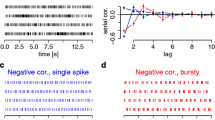Abstract
An experimentally recorded time series formed by the exact times of occurrence of the neuronal spikes (spike train) is likely to be affected by observational noise that provokes events mistakenly confused with neuronal discharges, as well as missed detection of genuine neuronal discharges. The points of the spike train may also suffer a slight jitter in time due to stochastic processes in synaptic transmission and to delays in the detecting devices. This study presents a procedure aimed at filtering the embedded noise (denoising the spike trains) the spike trains based on the hypothesis that recurrent temporal patterns of spikes are likely to represent the robust expression of a dynamic process associated with the information carried by the spike train. The rationale of this approach is tested on simulated spike trains generated by several nonlinear deterministic dynamical systems with embedded observational noise. The application of the pattern grouping algorithm (PGA) to the noisy time series allows us to extract a set of points that form the reconstructed time series. Three new indices are defined for assessment of the performance of the denoising procedure. The results show that this procedure may indeed retrieve the most relevant temporal features of the original dynamics. Moreover, we observe that additional spurious events affect the performance to a larger extent than the missing of original points. Thus, a strict criterion for the detection of spikes under experimental conditions, thus reducing the number of spurious spikes, may raise the possibility to apply PGA to detect endogenous deterministic dynamics in the spike train otherwise masked by the observational noise.






Similar content being viewed by others
References
Dayhoff, J.E., Gerstein, G.L.: Favored patterns in spike trains. I. Detection. J. Neurophysiol. 49, 1334–1348 (1983)
Abeles, M., Gerstein, G.: Detecting spatiotemporal firing patterns among simultaneously recorded single neurons. J. Neurophysiol. 60, 909–924 (1988)
Villa, A.E.P., Abeles, M.: Evidence for spatiotemporal firing patterns within the auditory thalamus of the cat. Brain Res. 509, 325–327 (1990)
Prut, Y., Vaadia, E., Bergman, H., Haalman, I., Slovin, H., Abeles, M.: Spatiotemporal structure of cortical activity—properties and behavioral relevance. J. Neurophysiol. 79, 2857–2874 (1998)
Tetko, I.V., Villa, A.E.P.: A pattern grouping algorithm for analysis of spatiotemporal patterns in neuronal spike trains. 2. Application to simultaneous single unit recordings. J. Neurosci. Methods 105, 15–24 (2001)
Villa, A.E.P., Tetko, I.V., Hyland, B., Najem, A.: Spatiotemporal activity patterns of rat cortical neurons predict responses in a conditioned task. Proc. Natl. Acad. Sci. U. S. A. 96, 1006–1011 (1999)
Villa, A.E.P.: Spatio-temporal patterns of spike occurrences in freely-moving rats associated to perception of human vowels. In: König, R., Heil, P., Budinger, E., Scheich, H. (eds.) Auditory Cortex: [T]owards a Synthesis of Human and Animal Research, chap. 17, pp. 241–254. Lawrence Erlbaum, Oxford (2005)
Tetko, I.V., Villa, A.E.P.: A comparative study of pattern detection algorithm and dynamical system approach using simulated spike trains. Lect. Notes Comput. Sci. 1327, 37–42 (1997)
Tetko, I.V., Villa, A.E.P.: Fast combinatorial methods to estimate the probability of complex temporal patterns of spikes. Biol. Cybern. 76, 397–407 (1997)
Tetko, I.V., Villa, A.E.P.: A pattern grouping algorithm for analysis of spatiotemporal patterns in neuronal spike trains. 1. Detection of repeated patterns. J. Neurosci. Methods 105, 1–14 (2001)
Abeles, M., Gat, I.: Detecting precise firing sequences in experimental data. J. Neurosci. Methods 107, 141–154 (2001)
Asai, Y., Yokoi, T., Villa, A.E.P.: Detection of a dynamical system attractor from spike train analysis. Lect. Notes Comput. Sci. 4131, 623–631 (2006)
Zaslavskii, G.M.: The simplest case of a strange attractor. Phys. Lett. 69A, 145–147 (1978)
Ikeda, K.: Multiple-valued stationary state and its instability of the transmitted light by a ring cavity system. Opt. Commun. 30, 257–261 (1979)
Chen, G., Ueta, T.: Yet another chaotic attractor. Int. J. Bifurc. Chaos 9, 1465–1466 (1999)
Abeles, M.: Local Cortical Circuits. Springer, Heidelberg (1982)
Villa, A.E.P., Tetko, I.V.: Spatiotemporal activity patterns detected from single cell measurements from behaving animals. Proc. SPIE 3728, 20–34 (1999)
Rapp, P.E.: Chaos in the neurosciences: cautionary tales from the frontier. Biologist 40, 89–94 (1993)
Celletti, A., Villa, A.E.P.: Determination of chaotic attractors in the rat brain. J. Stat. Phys. 84, 1379–1385 (1996)
Celletti, A., Villa, A.E.P.: Low dimensional chaotic attractors in the rat brain. Biol. Cybern. 74, 387–394 (1996)
Celletti, A., Bajo Lorenzana, V.M., Villa, A.E.P.: Correlation dimension for two experimental time series. J. Stat. Phys. 89, 877–884 (1997)
Celletti, A., Froeschlé, C., Tetko, I.V., Villa, A.E.P.: Deterministic behaviour of short time series. Meccanica 34, 145–152 (1999)
Izhikevich, E.M.: Neural excitability, spiking and bursting. Int. J. Bifurc. Chaos 10, 1170–1266 (2000)
Asai, Y., Yokoi, T., Villa, A.E.P.: Deterministic nonlinear spike train filtered by spiking neuron model. Lect. Notes Comput. Sci. 4668, 924–933 (2007)
Kostelich, E.J., Schreiber, T.: Noise reduction in chaotic time-series data: a survey of common methods. Phys. Rev. E 48, 1752–1763 (1993)
Aksenova, T.I., Chibirova, O., Dryga, A.O., Tetko, I.V., Benabid, A., Villa, A.E.P.: An un-supervised automatic method for sorting neuronal spike waveforms in awake and freely moving animal. Methods 30, 178–187 (2003)
Asai, Y., Aksenova, T.I., Villa, A.E.P.: On-line real-time oriented application for neuronal spike sorting with unsupervised learning. Lect. Notes Comput. Sci. 3696, 109–114 (2005)
Segundo, J.P.: Nonlinear dynamics of point process systems and data. Int. J. Bifurc. Chaos 13, 2035–2116 (2003)
Acknowledgements
This study was partially funded by the binational JSPS/INSERM grant SYRNAN (2007–2008) and the Japan–France Research Cooperative Program.
Author information
Authors and Affiliations
Corresponding author
Rights and permissions
About this article
Cite this article
Asai, Y., Villa, A.E.P. Reconstruction of Underlying Nonlinear Deterministic Dynamics Embedded in Noisy Spike Trains. J Biol Phys 34, 325–340 (2008). https://doi.org/10.1007/s10867-008-9093-0
Received:
Accepted:
Published:
Issue Date:
DOI: https://doi.org/10.1007/s10867-008-9093-0




